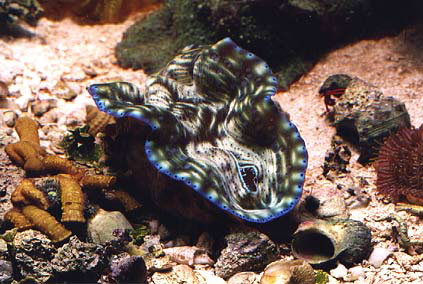![]()
![]()

A juvenile giant clam (Tridacna derasa) in the reef aquarium.
Other organisms visible in photo:
Giant Clams:
The juvenile giant clam (Tridacna derasa) that occupies the sand
in the front of the reef aquarium has the potential of growing to 2 feet
in length, though this takes time. Only one other clam species grows larger:
the closely related Tridacna gigas may exceed 4 feet in length!
Giant clams have large, colorful mantles inhabited by dense populations of symbiotic dinoflagellate algae called zooxanthellae. The clams extend their mantles to capture light for photosynthesis by their algal symbionts. The algae use sunlight energy to manufacture sugars and other energy-rich compounds that feed both themselves and their giant clam hosts. Though the clams also get some nutrition by filtering bacteria and other microorganisms from the water, most of their energy comes from their algal symbionts. Indeed, one of the most important prerequisites for keeping giant clams healthy in captivity is intense lighting. (Note: as described in other picture captions, all of our anemones and corals are also fed by zooxanthellae living within their tissues.)
Giant clams are commonly eaten by humans in the Indo-Pacific region, and overcollecting by burgeoning human populations have driven these clams to the brink of extinction over much of their natural range. In response to this crisis, scientists have developed methods of breeding these clams in captivity. Giant clam farms have now been established populations in Micronesia, the Philippines, Australia, and other countries in the Indo- Pacific region for production of clam meat and juvenile clams to restock wild populations. A byproduct of these efforts is that juvenile giant clams such as the one in our aquarium have become available in the aquarium trade.